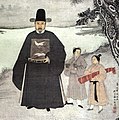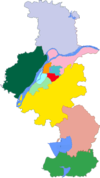Nanjing Museum
南京博物院 | |
 The Nanjing Museum exterior | |
 | |
| Established | 1933 |
|---|---|
| Location | Nanjing, China |
| Type | History museum, art museum |
| Website | www |
The Nanjing Museum (Chinese: 南京博物院; pinyin: Nánjīng Bówùyuàn) is located in Nanjing, the capital of Jiangsu Province in East China. With an area of 70,000 square metres (17 acres),[1] it is one of the largest museums in China. The museum has over 400,000 items in its permanent collection,[2] making it one of the largest in China. Especially notable is the museum's enormous collections of Ming and Qing imperial porcelain, which is among the largest in the world.[3]
History
The Nanjing Museum was one of the first museums established in China. The predecessor of the Nanjing Museum was the preparatory department of the National Central Museum,[4] which established in 1933. The museum took over 12.9 hectares (32 acres) in the Half Hill Garden of Zhongshan Gate. Cai Yuanpei, the first preparatory president of the council of the museum, proposed building three major halls, named "Humanity," "Craft" and "Nature". Because of China's political instability in the 1930s, only the Humanity Hall was built.[5] During the Japanese invasion, part of its collections were transferred to Southwest China, and in the end moved to the National Palace Museum in Taipei when the Kuomintang lost the Chinese Civil War.[4] The historian Fu Sinian and anthropologist and archaeologist Li Ji were once preparatory presidents, and the archaeologist and museologist Zeng Zhaoyu was the first female president and also a founder of Nanjing Museum. In 1999 and 2009, extensions were built to the museum.
Buildings

The main building was designed by Liang Sicheng in the 1930s combining Chinese and Western architectural styles. The front section is structure of traditional style and features a golden tiled roof. In the back is a Western-style flat-roof structure. Added in the 1990s to the west of the main building is an art hall which references Chinese architecture of the first half of the 20th century.[1]
Exhibition halls
There are twelve exhibition halls at the museum. A highlight of the collection is a full-size suit of armor made from small jade tiles held together by silver wire.
- Qin Garden
- Earthen Ware Hall
- Treasure Hall
- Folk Art Hall
- Bronze Ware Hall
- Ming and Qing Porcelain Hall
- Wu Weishan Sculpture Hall
- Ancient Paintings Hall
- Modern Art Hall
- Jiangnan Silk Product Hall
- Jade Hall
- Lacquer Hall
Gallery
Paintings
-
Giant Bamboos and Stones by Li Kan (1245-1320), 13th century
-
A Ming portrait of the official Jiang Shunfu, late 15th century
-
Watching the Spring and Listening to the Wind by Tang Yin (1470–1524), early 16th century
-
Camellia and a Lonely Bird by Zhou Shuxi (1624–1705)
-
Fisherman and Fisherwoman by Huang Shen (1687-1772)
-
Four Beauties by Ni Tian (1855–1919)
Lacquer
-
A Western Han (202 BC - 9 AD) red-and-black rectangular lacquerware box
-
A Ming Dynasty (1368-1644) black lacquerware plate
-
A Ming red lacquered bowl
-
A pair of Ming Dynasty black lacquerware plates with mother-of-pearl inlaid designs of domestic scenes.
-
A Qing red lacquerware box with the Chinese character for "spring" inscribed on the front, dated to the Qianlong Emperor's reign (1736-1795)
-
A red lacquerware plate, dated to the Qianlong Emperor's reign
Ceramics
-
A Western Jin Dynasty (265-316 AD) celadon ceramic jar with human figures, animals, and architecture.
-
A Song Dynasty (960-1279 AD) porcelain box with a flower design
-
A Ming Dynasty (1368-1644 AD) porcelain dish from the reign of the Hongwu Emperor (1368-1398 AD)
-
A Ming blue-and-white porcelain vase from the reign of the Yongle Emperor (1402-1424 AD)
-
A Ming blue-and-white porcelain dish from the reign of the Xuande Emperor (1425-1435 AD)
-
A Ming blue-and-white porcelain ding vessel from the reign of the Xuande Emperor (1425-1435 AD).
-
A Ming porcelain vase from the reign of the Zhengde Emperor (1505-1521 AD).
-
A Ming blue-and-white porcelain dish from the reign of the Jiajing Emperor (1521-1567 AD)
-
A Ming porcelain bowl from the reign of the Wanli Emperor (1572-1620 AD).
-
A Ming blue-and-white porcelain vase from the reign of the Wanli Emperor (1572-1620 AD)
-
A Ming blue-and-white porcelain box from the reign of the Wanli Emperor (1572-1620 AD)
-
A Ming blue-and-white porcelain bowl from the reign of the Chongzhen Emperor (1627-1644 AD)
See also
References
- ^ a b Gong Liang. "Nanjing Museum". China & World Cultural Exchange. 2006 (5): 16–19.
- ^ "Treasures in Nanjing Museum". Chinaculture.org. 2008-07-14. Archived from the original on 2013-03-04. Retrieved 2013-09-12.
- ^ "Porcelain Creatures Highlight Nanjing Museum". China.org.cn. 2003-10-29. Retrieved 2013-09-12.
- ^ a b "National Palace Museum". artinasia.com. Retrieved 2012-01-10.
- ^ "Nanjing Museum: History". Nanjing Museum. Archived from the original on 2012-09-04. Retrieved 2012-01-10.
External links
- Official website (in Chinese and English)
























